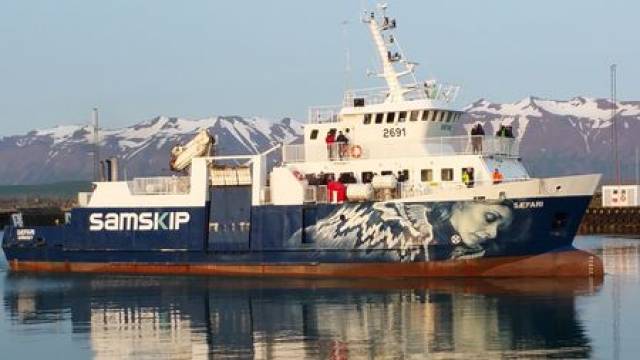#ÁrannSæfari - The return of Ireland's largest domestic freighter, Bláth na Mara, this week on the Galway-Aran Islands routes recalls memories of a predecessor that remains in service albeit in Icelandic waters, writes Jehan Ashmore.
The predecessor is not to be mistaken for the Naomh Éanna, the veteran vessel dating to 1958 was decommissioned on the CIE operated service that closed in 1988. Unfortunately, the Dublin built ship remains languishing in the capital despite plans to bring her back to Galway. As previously reported she again faces the threat of scrapping!
In fact the last such ship serving scheduled Aran Islands services from Galway Port was the Oileáin Árann. Notably, this vessel was also the final ship to carry ‘passengers’ from the city on a service that combined freight when operated by Doolin based O’Brien Shipping.
At 416 gross tonnage Oileáin Árann (photo) is larger to the Bláth na Mara with a tonnage of 330. This 36m freight-only vessel operates Ireland’s longest distance domestic freight route run by Lasta Mara Teoranta that took over the Government contracted service in 2005. In the following year Oileáin Árann was sold to the then Icelandic owned operator, Samskip which renamed the ship Sæfari.
The almost 40m Sæfari, is part of a giant global logistics company based in Rotterdam from where subsidiary Samskip Multimodal BV operate lo-lo container feeder services to the island of Ireland. Tonight in Dublin Port is berthed their Samskip Express which arrived from Rotterdam. The next port of call is Belview, the main terminal for the Port of Waterford.
On introduction to Irish owners of the Oileáin Árann in 1992, the vessel presented a rather unusual looking appearance on the Aran run given a forward superstructure accommodating passengers complete with a tower-like wheelhouse a deck above. This deck arrangement resembled that of an offshore oil supply support /standby ship and as if based out of Aberdeen to serve in the North Sea.
Oileáin Árann was a custom-built passenger freight ship ordered in the UK, that firstly involved Brombrough based McTay Marine, England, to build the hull. As for the balance of work this was contracted to their then Scottish associates James Miller of St. Monans, Fife. Both these firms are no longer in business but perhaps there is some merit to my theory as to the background of the Fife yard's naval architecture given the Forth of Fife remains synonymous with the oil sector. This is where anchored inactive North Sea rig platforms can be found and BP’s (Crude Oil) Hound Point Marine Terminal.
The Oileáin Árann loaded cargo on board using a deck-mounted crane located on the aft freight deck. Also located here are twin funnels lining along the ships side. It was during a visit to Galway Port, that I observed from the outer pier the dual-purpose vessel depart through the Dun Aengus Dock. These days such services (freight-only) take place at the outer pier.
Under current owners, Samskip undertook rebuilding the vessel that involved an enlarged superstructure. The conversion included work at the aft deck with the fitting of a stern-loading vehicle ramp and a side-loading door for additional ro-ro access.
So the former Aran Islands ship now car-ferry Sæfari operates scheduled trips from Dalvík to Hrisey and Grímsey, Iceland´s northernmost inhabited island of around 100 persons. Most of whom are employed in the fishing industry. Asides the attraction of wildlife for tourists, the Arctic Circle runs right through the middle of Grímsey. Those who enter the Circle receive a special illuminated certificate to confirm their adventure.
As far as current Irish operations are concerned, the recent relief ro-ro ferry Chateau-Thierry (that stood in for Bláth na Mara) has a bow-loading vehicle ramp and a deck mounted crane. Galway port however does not feature a slipway nor indeed a linkspan for more conventional tonnage such as the Sæfari.































































